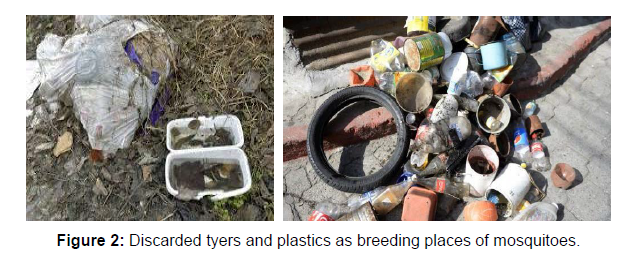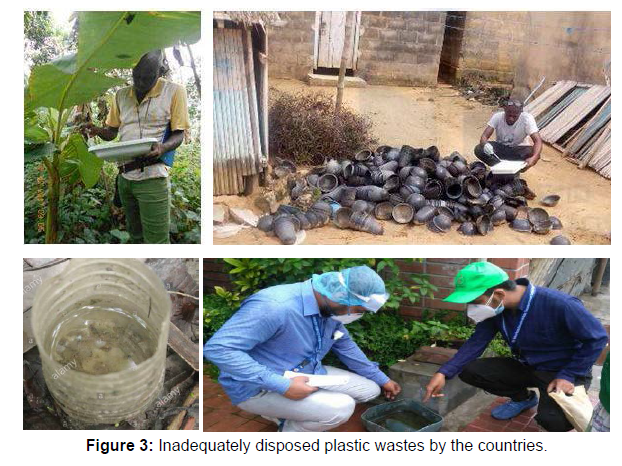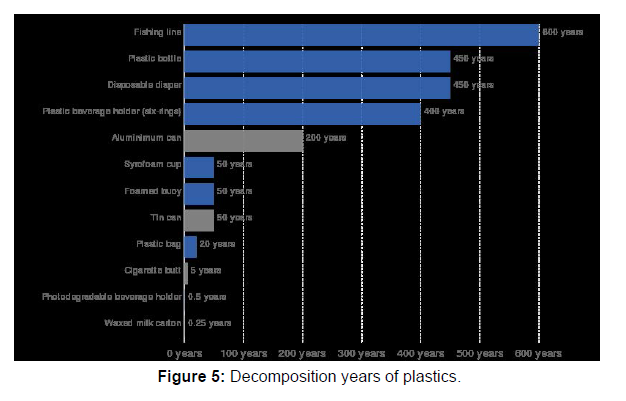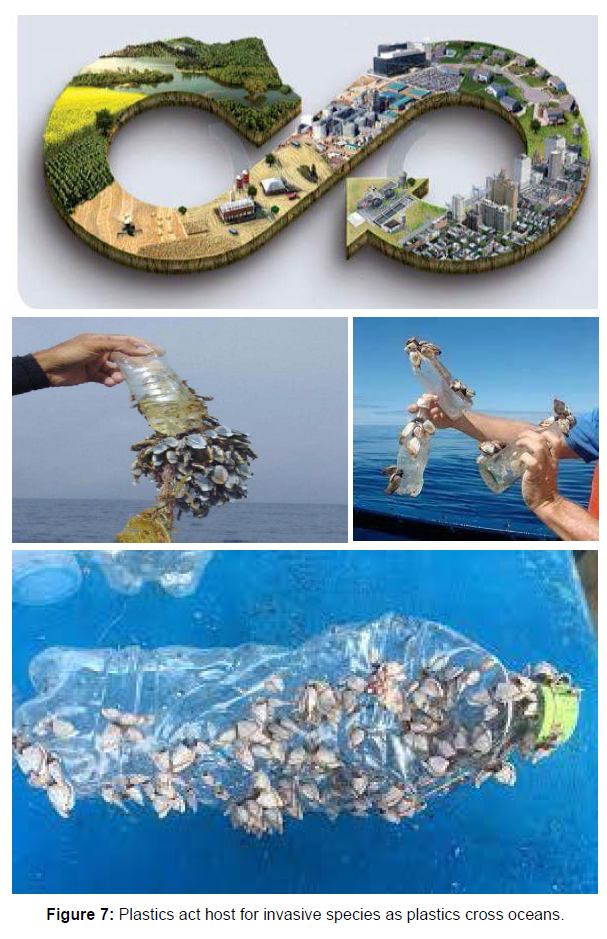Discarded Plastics as an Important Absorbent of Chemicals, Breeding Places of Mosquitoes as Vectors of Diseases and Transferring Environmental Pollutants and Invasive Species Worldwide
Received: 08-Feb-2022 / Manuscript No. TYOA-22-51985 / Editor assigned: 11-Feb-2022 / PreQC No. TYOA-22-51985 / Reviewed: 25-Feb-2022 / QC No. TYOA-22-51985 / Revised: 08-Jun-2022 / Manuscript No. TYOA-22-51985 / Published Date: 13-Apr-2022 DOI: 10.4172/2476-2067.1000188
Abstract
Introduction: Plastics are now the most widely used man-made substances and have become omnipresent in every aspect of our lives. From medical supplies and water bottles to food packaging, clothing, and construction materials. Discarded plastics play important role as breeding places for mosquitoes as vectors of different disease such malaria, dengue, West Nile virus, chikungunya, yellow fever, filariasis, tularemia, dirofilariasis, Japanese encephalitis, Saint Louis encephalitis, Western equine encephalitis, Eastern equine encephalitis, Venezuelan equine encephalitis, Ross River fever, Barmah Forest fever, La Crosse encephalitis, and Zika fever, as well as newly detected Keystone virus and Rift Valley fever.
Aim: In addition the Food and Agriculture (FAO) and World Health Organization (WHO) recommended several chemicals for control of pests in agriculture, horticulture, veterinary, stored product pests, and public health pests and vectors.
Methods: All the documents related to the subject were collected from international journals and internet.
Results: The discarded plastics absorb these chemicals and transfer in to different parts of world. One pre-production plastic pellet can have up to 1 million times higher concentration of pesticides than an equal volume of seawater. The discarded plastics which absorb pesticides can act as breeding places of mosquitoes and may cause insecticide resistance in the vectors.
Travelling the discarded plastics from one region to another region of the world through the seas, oceans and rivers may transport unwanted and harmful creature through the world. Plastic is persistent and plastic doesn’t biodegrade. No bacteria exists which can digest plastic polymers.
Conclusion: Management on appropriate use of plastics and education to the people around the word about side effects of these materials will help for the safety and health of people in the world.
Keywords
Plastics; Discard; Side effect; World human health
Introduction
According to the Food and Agriculture (FAO) and World Health Organization (WHO several chemicals have been recommended for control of pests in agriculture, horticulture, veterinary, Stored product pests, and public health pests and vectors [1] (Table 1).
| Type | Action |
|---|---|
| Algicides | Control algae in lakes, canals, swimming pools, water tanks, and other sites |
| Antimicrobials | Kill microorganisms (such as bacteria and viruses) |
| Attractants | Attract pests (for example, to lure an insect or rodent to a trap). (However, food is not considered pesticide when used as an attractant.) |
| Biopesticides | Biopesticides are certain types of pesticides derived from such natural materials as animals, bacteria, and certain minerals |
| Biocides | Kill microorganisms |
| Disinfectants and sanitizers | Kill or inactivate disease-producing microorganisms on inanimate objects |
| Fungicides | Kill fungi (including blights, mildews, molds, and rusts) |
| Fumigants | Produce gas or vapor intended to destroy pests in buildings or soil |
| Herbicides | Kill weeds and other plants that grow where they are not wanted |
| Insecticides | Kill insects and other arthropods |
| Miticides | Kill mites that feed on plants and animals |
| Microbial pesticides | Microorganisms that kill, inhibit, or out compete pests, including insects or other microorganisms |
| Molluscicides | Kill snails and slugs |
| Nematicides | Kill nematodes (microscopic, worm-like organisms that feed on plant roots) |
| Ovicides | Kill eggs of insects and mites |
| Pheromones | Biochemicals used to disrupt the mating behavior of insects |
| Repellents | Repel pests, including insects (such as mosquitoes) and birds |
Table 1. The main chemicals for control of pests worldwide
Organochlorine Pesticides: DDT
Organophospahte Pesticides: parathion, malathion, methyl parathion, chlorpyrifos, dichlorvos, phosmet, fenitrothion, tetrachlorvinphos, azamethiphos, azinphos-methyl, terbufos, temephos, diazinon,
Pyrethroids Pesticides: allethrin, bifenthrin, cyfluthrin, cypermethrin, alpha-cypermethrin, cyphenothrin, deltamethrin, dibromovinyl, esfenvalerate, etofenprox, fenpropathrin, fenvalerate, flucythrinate, flumethrin, imiprothrin, lambda-cyhalothrin, metofluthrin, permethrin, phenothrin, prallethrin, resmethrin, silafluofen, sumithrin, tau-fluvalinate, tefluthrin, tetramethrin, tralomethrin, transfluthrin,
Carbamates Pesticides: aldicarb, aminocarb, bendiocarb, butocarboxim, carbaryl, carbofuran, carbosulfan, cumenyl methylcarbamate, dimetilan, ethiofencarb, fenobucarb, fenoxycarb, formetanate, formparanate, methiocarb, methomyl, metolcarb, mexacarbate, oxamyl, pirimicarb, promecarb, propoxur, thiofanox
Herbicides: 2,4-D, alachlor, alachlor + atrazine, atrazine,bensulide, bentazon, benefiin, bicyclopyrone, capric, carfentrazone-ethyl,clethodim, clomazone, clopyralid, cycloate, cyclohexylethylthiocarbamate, dcpa, dimethenamid, eptc, ethalfluralin, ethalfluralin + clomazone, ethofumesate, fluazifop, flumioxazin, fluthiacet-methyl, fluthiacet-methyl + mesotrione, fomesafen, glyphosate, halosulfuron-methyl, imazethapyr, imazosulfuron, linuron, mesotrione, metolachlor, metribuzin, (dimetric, metribuzin, napropamide, nicosulfuron, nicosulfuron + mesothione, norflurazon, oxyfluorfen, paraquat, pelargonic acid, pendimethalin, phenmedipham, prometryn, pronamide, pyraflufen-ethyl, pyroxasulfone, quizalofop p- ethyl, rimsulfuron, saflufenacil, simazine, s-metolachlor, sulfentrazone, tembotrione, terbacil, topramezone, trifloxyfulfuronsodium, trifluralin, triflusulfuron,
Fungicides: 2-methoxyethylmercury chloride, 2-phenylphenol,8-hydroxyquinoline sulfate, 8-phenylmercurioxyquinoline, acibenzolar, acylamino acid, acypetacs, aldimorph, aliphatic nitrogen fungicides, allyl alcohol, amide fungicides, ampropylfos, anilazine, anilide,aureofungin, azaconazole, azithiram, azoxystrobin, barium polysulfide, benalaxyl, benalaxyl-M, benodanil, benomyl, benquinox, bentaluron, benthiavalicarb, benzalkonium chloride, benzamacril, benzamide, benzamorf, benzanilide, benzimidazole, benzimidazole, benzimidazolylcarbamate, benzohydroxamic acid, benzothiazole fungicides, bethoxazin, binapacryl, biphenyl, bitertanol, bithionol, bixafen, blasticidin-S, Bordeaux mixture, boric acid, boscalid, bridged diphenyl, bromuconazole, bupirimate, Burgundy mixture, buthiobate, sec-butylamine, calcium polysulfide, captafol, captan,,carbamorph, carbanilate, carbendazim, carboxin, carpropamid, carvone, Cheshunt, mixture, chinomethionat, chlobenthiazone, chloraniformethan, chloranil, chlorfenazole, chlorodinitronaphthalene, chloroform, chloroneb, chloropicrin, chlorothalonil, chlorquinox, chlozolinate, ciclopirox, climbazole, clotrimazole, conazole, imidazoles, triazoles, copper(II) acetate, copper(II) carbonate, copper hydroxide, copper naphthenate, copper oleate, copper oxychloride, copper(II) sulfate, copper sulfate, copper zinc, chromate, cresol, cufraneb, cuprobam, cuprous oxide, cyazofamid, cyclafuramid, cyclic dithiocarbamate, cycloheximide, cyflufenamid, cymoxanil, cypendazole, cyproconazole, cyprodinil, dazomet, DBCP, debacarb, decafentin, dehydroacetic acid, dicarboximide, dichlofluanid, dichlone, dichlorophen, dichlorophenyl, dichlozoline, diclobutrazol, diclocymet, diclomezine, dicloran, diethofencarb, diethyl pyrocarbonate, difenoconazole, diflumetorim, dimethirimol, dimethomorph, dimoxystrobin, diniconazole, diniconazole-M, dinitrophenol,dinobuton, dinocap, dinocap-4, dinocap-6, dinocton, dinopenton, dinosulfon, dinoterbon, diphenylamine, dipyrithione, disulfiram, ditalimfos dithianon, dithiocarbamate,DNOC, dodemorph, dodicin, dodine, donatodine, drazoxolon, edifenphos, epoxiconazole, etaconazole, etem, ethaboxam, ethirimol, ethoxyquin, ethylene oxide, ethylmercury 2,3-dihydroxypropyl mercaptide, ethylmercury acetate, ethylmercury bromide, ethylmercury chloride, ethylmercury phosphate, etridiazole, famoxadone, fenamidone, fenaminosulf, fenapanil, fenarimol, fenbuconazole, fenfuram, fenhexamid, fenitropan, fenoxanil, fenpiclonil, fenpropidin, fenpropimorph, fentin, ferbam, ferimzone, fluazinam, fluconazole, fludioxonil, flumetover, flumorph, fluopicolide, fluoroimide, fluotrimazole, fluoxastrobin, fluquinconazole, flusilazole, flusulfamide, flutolanil, flutriafol, fluxapyroxad, folpet, formaldehyde, fosetyl, fuberidazole, furalaxyl, furametpyr, furamide, furanilide, furcarbanil, furconazole, furconazole-cis, furfural, furmecyclox, furophanate, glyodin, griseofulvin, guazatine, halacrinate, hexachlorobenzene, hexachlorobutadiene, hexachlorophene, hexaconazole, hexylthiofos, hinokitiol, hydrargaphen, hymexazol, imazalil, imibenconazole, imidazole,iminoctadine, inorganic mercury, iodomethane, ipconazole, iprobenfos, iprodione, iprovalicarb, isavuconazole, isopropyl alcohol, isoprothiolane, isovaledione, isopyrazam, itraconazole, kasugamycin, ketoconazole, kresoxim-methyl, Lime sulfur,mancopper, mancozeb, maneb, mebenil, mecarbinzid, mepanipyrim, mepronil, mercuric chloride, mercuric oxide,mercurous chloride, metalaxyl, metalaxyl-M, metam, metazoxolon, metconazole, methasulfocarb, methfuroxam, methyl bromide, methyl isothiocyanate, methylmercury benzoate, methylmercury dicyandiamide, methylmercury, pentachlorophenoxide, metiram, metominostrobin, metrafenone, metsulfovax, milneb, morpholine, myclobutanil, myclozolin, N-(ethylmercury)-p-toluenesulfonanilide, nabam, natamycin, nystatin, β-nitrostyrene, nitrothal-isopropyl, nuarimol, OCH, octhilinone, ofurace,oprodione, organomercury fungicides, organophosphorus fungicides, organotin fungicides, orthophenyl phenol, orysastrobin, oxadixyl, oxathiin fungicides, oxazole fungicides, oxine copper, oxpoconazole, oxycarboxin, paclobutrazol, pefurazoate, penconazole, pencycuron, pentachlorophenol, penthiopyrad, phenylmercuriurea, phenylmercury acetate, phenylmercury chloride, phenylmercury derivative of pyrocatechol, phenylmercury nitrate, phenylmercury salicylate, phenylsulfamide fungicides, phosdiphen, Phosphite, phthalide, phthalimide fungicides, picoxystrobin, piperalin, polycarbamate, polymeric dithiocarbamate fungicides, polyoxins, polyoxorim, polysulfide fungicides, posaconazole, potassium azide, potassium polysulfide, potassium thiocyanate, pramiconazole, probenazole, prochloraz, procymidone, propamocarb, propiconazole, propineb, proquinazid, prothiocarb, prothioconazole, pterulone, pyracarbolid, pyraclostrobin, pyrazole fungicides, pyrazophos, pyridine fungicides, pyridinitril, pyrifenox, pyrimethanil, pyrimidine fungicides, pyroquilon, pyroxychlor, pyroxyfur, pyrrole fungicides, quinacetol, quinazamid, quinconazole, quinoline fungicides, quinomethionate, quinone fungicides, quinoxaline fungicides,quinoxyfen, quintozene, rabenzazole, ravuconazole, salicylanilide, silthiofam, silver, simeconazole, sodium azide, sodium bicarbonate, sodium orthophenylphenoxide, sodium pentachlorophenoxide, sodium polysulfide, spiroxamine, streptomycin, strobilurin fungicides, sulfonanilide fungicides, sulfur, sulfuryl fluoride, sultropen, TCMTB, tebuconazole, tecloftalam, tecnazene, tecoram, tetraconazole, thiabendazole, thiadifluor, thiazole fungicides, thicyofen, thifluzamide, thujaplicins, thymol, triforine, thiocarbamate fungicides, thiochlorfenphim, thiomersal, thiophanate, thiophanatemethyl, thiophene fungicides, thioquinox, thiram, tiadinil, tioxymid, tivedo, tolclofos-methyl, tolnaftate, tolylfluanid, tolylmercury acetate, triadimefon, triadimenol, triamiphos, triarimol, triazbutil, triazine fungicides, triazole fungicides, triazoxide, tributyltin oxide, trichla mide,tricyclazole,tridemorph, trifloxystrobin, triflumizole,triforine, triticonazole, unclassified fungicides, Undecylenic acid, uniconazole, uniconazole-P, urea fungicides, validamycin, valinamide fungicides, vinclozolin, voriconazole, zarilamid, zinc naphthenate, zineb, ziram. Mosquito-borne diseases or mosquito-borne illnesses are diseases caused by bacteria, viruses or parasites transmitted by mosquitoes. Nearly 700 million people get a mosquito-borne illness each year resulting in over one million deaths.. Diseases transmitted by mosquitoes include malaria, dengue, West Nile virus, chikungunya, yellow fever, filariasis, tularemia, dirofilariasis, Japanese encephalitis, Saint Louis encephalitis, Western equine encephalitis, Eastern equine encephalitis, Venezuelan equine encephalitis, Ross River fever, Barmah Forest fever, La Crosse encephalitis, and Zika fever, as well as newly detected Keystone virus and Rift Valley fever. Figure 1shows the global dead due to vector-borne diseases. Mosquitoes including Anopheles, Aedes and Culex species lay their eggs in the water. After raining all the discarded tyers and plastics will fill with water. These discarded plastics play an important role as breeding places of mosquitoes (Fig. 2). After emerging of mosquitoes from breeding places they transmit different diseases to human. There are several outbreaks of mosquito-borne diseases in the discarded tiyers and plastics in the world [2]
Persistent Organic Pollutants (POPs): POPs includes: pesticides, industrial chemicals and waste by- products. These POPs are: aldrin, chlordane. dichlorodiphenyl trichloroethane (DDT), dieldrin, endrin, heptachlor, hexachlorobenzene, mirex, toxaphene, polychlorinated biphenyls (PCBs), polychlorinated dibenzo-p-dioxins(dioxins), polychlorinated dibenzofurans (furans). They remain intact for exceptionally long periods of time (many years); become widely distributed throughout the environment as a result of natural processes involving soil, water and,most notably, air; accumulate in the fatty tissue of living organisms including humans, and are found at higher concentrations at higher levels in the food chain; and are toxic to both humans and wildlife (Figures 1 and 2).
Plastics are now the most widely used man-made substances and have become omnipresent in every aspect of our lives (Figure 3).
From medical supplies and water bottles to food packaging, clothing, and construction materials. Plastic pollution has now become widely recognized as a major environmental burden (Fig.4), particularly in the oceans where the biophysical breakdown of plastics is prolonged, effects on wildlife are severe, and options for removal are very limited. Because of their very high molecular weight and lack of natural analogues, conventional plastics do not easily biodegrade in the marine or terrestrial environment, and may just disintegrate physically [3]. Many plastics have the capacity to adsorb both organic and metal pollutants (including most known POPs) from the environment and concentrate these up to 1 million-fold relative to concentrations found in seawater. Possible direct toxic effects from plastics and enhanced transfer of environmental pollutants via adsorption and transfer to organisms. Chemicals can transfer from plastic to animal. Plastics will remain an important material in humanity’s future. Plastics are: durable, lightweight, cheap, versatile. Plastic is persistent and plastic doesn’t biodegrade. No bacteria exists which can digest plastic polymers. Pre-production plastic pellets (nurdles) absorb Persistent Organic Pollutants (POPs). One pre- production plastic pellet can have up to 1 million times higher concentration of POPs than an equal volume of seawater. Decomposing of plastics in the nature take around 600 years (Figure 4). The plastics that most pollute the seas and oceans are not even visible. About 92% of the more than five trillion pieces of plastic waste floating on the surface form so-called microplastics. These are small particles with a diameter of up to 5 millimeters. They pose a serious problem not only at sea, as they can be found in large [4]Plastic pollution can afflict land, waterways and oceans. It is estimated that 1.1 to 8.8 million tons of plastic waste enters the ocean from coastal communities each year. Scientists predict 700 million tons of plastic waste by 2040. Single use plastics are projected to increase by over 40 per cent in the next ten years and the amount of plastic flowing into oceans each year will more than double by 2040. In the nature several creature my suffer from plastic and effect on their physiology and longevity[5] (Figures 5 and 6).
Authors Contributions:
Involved
Funding:
Not applicable
Competing Interest:
The author declare that there is no conflict of interest.
Availability of data and materials:
Applicable
References
- Van den Berg H (2009)Global status of DDT and its alternatives for use in vector control to prevent disease.Environ Health Perspect117, 1656–1663.
- Hille B (1968)Pharmacological modifications of the sodium channels of frog nerveJ Gen Physiol51, 199–219
- Soderlund D M, and Bloomquist J R (1989)Neurotoxic actions of pyrethroid insecticides.Annu Rev Entomol34, 77–96.
- Vijverberg H P, and van den Bercken J (1990)Neurotoxicological effects and the mode of action of pyrethroid insecticides.Crit Rev Toxicol21, 105–126 .
- Bloomquist J R (1996)Ion channels as targets for insecticides.Annu Rev Entomol41, 163–190.
- Davies T G, Field L M, Usherwood P N, and Williamson M S (2007)DDT, pyrethrins, pyrethroids, and insect sodium channels .IUBMB Life59, 151–162.
- Dong K, Du Y, Rinkevich F, Nomura Y, Xu P, Wang L, Silver K, and Zhorov B S (2014)Molecular biology of insect sodium channels and pyrethroid resistance.Insect Biochem Mol Biol50, 1–17.
Indexed at, Google Scholar, Crossref
Indexed at, Google Scholar, Crossref
Indexed at, Google Scholar, Crossref
Indexed at, Google Scholar, Crossref
Indexed at, Google Scholar, Crossref
Citation: Vatandoost H (2022) Discarded Plastics as an Important Absorbent of Chemicals, Breeding Places of Mosquitoes as Vectors of Diseases and Transferring Environmental Pollutants and Invasive Species Worldwide. Toxicol Open Access 8:183. DOI: 10.4172/2476-2067.1000188
Copyright: © 2022 Vatandoost H. This is an open-access article distributed under the terms of the Creative Commons Attribution License, which permits unrestricted use, distribution, and reproduction in any medium, provided the original author and source are credited.
Select your language of interest to view the total content in your interested language
Share This Article
Open Access Journals
Article Tools
Article Usage
- Total views: 2263
- [From(publication date): 0-2022 - Nov 10, 2025]
- Breakdown by view type
- HTML page views: 1779
- PDF downloads: 484







